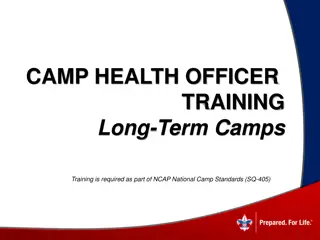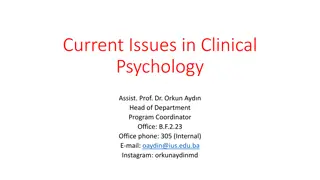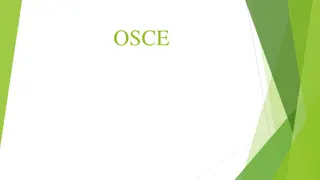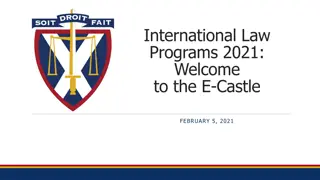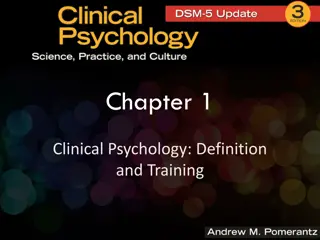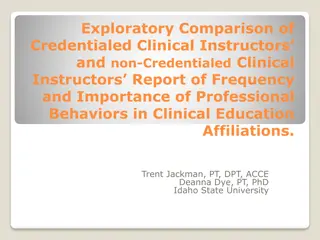
Clinical Officers and Primary Care Clinicians in Africa
Explore the development of clinical officers in primary care across Africa, emphasizing the importance of universal health coverage, equity, and access in healthcare. Learn about the roles of various healthcare providers like clinical officers, physician assistants, and medical assistants as key contributors to quality healthcare delivery.
Download Presentation

Please find below an Image/Link to download the presentation.
The content on the website is provided AS IS for your information and personal use only. It may not be sold, licensed, or shared on other websites without obtaining consent from the author. If you encounter any issues during the download, it is possible that the publisher has removed the file from their server.
You are allowed to download the files provided on this website for personal or commercial use, subject to the condition that they are used lawfully. All files are the property of their respective owners.
The content on the website is provided AS IS for your information and personal use only. It may not be sold, licensed, or shared on other websites without obtaining consent from the author.
E N D
Presentation Transcript
Development of PHC Clinicians in Africa Clinical Officers in Primary Care - An international perspective Scott Smalley, MSPAS, PA-C, Clinical Associate President International Academy of Physician Associate Educators (IAPAE) Head of Division of Clinical Associates, University of Witwatersrand, Johannesburg, South Africa
WHO - Universal Health Coverage and Primary Health Care - three related objectives: UHC embodies equity in access to health services - everyone who needs services should get service The quality of health services should be good enough to improve the health of those receiving services; and People should be protected against financial-risk (access), ensuring that the cost of using services does not put people at risk of financial harm. Primary Health Care is an approach to health and wellbeing centred on the needs and circumstances of individuals, families and communities
Equity, Quality & Access We live in an unequal world and we cannot leave anyone behind. Currently, 50 million people are displaced from their homes and communities. Just 62 people control half of the world s wealth. Twenty- two million people lack access to HIV treatment and 17.1 million people still do not know their HIV status. Michel Sidib , Executive Director of UNAIDS and Under Secretary General of the United Nations. January 2016
Define Clinical Officer, Physician Assistant, Clinical Associate, Medical Assistant & Comparable Terms in the literature: Auxiliary Health Worker, Non-Physician Clinician, Mid-Level Provider, Advanced Practice Provider WHO Definition: Health workers trained at a higher education institution for at least 2-3 years. They are authorized to work autonomously to diagnose, manage and treat illness, disease and impairments, as well as engage in preventive and promotive care (WHO 2007)
History of CO/PA Analogue terms by countries Feldsher 1400s. In Russia, they were regarded as "Middle Medical Workers" Barefoot doctor 1930, In China, provide health to rural areas, promotive healthcare. End 1981, now with Doctor Assistant Health Auxiliaries were used in India since the late 19th century to work in disease control and eradication In Africa 1918. Medical Assistant, Health Assistant, Health Officer. Grew into Clinical Officer 1928, also Assistant Medical Officer 1984, Medical Licentiate 2002 United States & Liberia Physician Assistant 1965, UK-Physician Associate 2003, South Africa -Clinical Associate 2008 55+ countries with a Mid Level Healthcare Provider (MLP)
ISCO 2008 In Major Group 2: Health Professionals Health Professional Paramedical Practitioner Paramedical practitioners provide advisory, diagnostic, curative and preventive medical services for humans more limited in scope and complexity than those carried out by medical doctors. They work autonomously, or with limited supervision of medical doctors, and apply advanced clinical procedures for treating and preventing diseases, injuries and other physical or mental impairments common to specific communities. Tasks include (a) conducting physical examinations of patients and interviewing them and their families to determine their health status, and recording patients medical information; (b) performing basic or more routine medical and surgical procedures, including prescribing and administering treatments, medications and other preventive or curative measures, especially for common diseases and disorders; (c) administering or ordering diagnostic tests, such as X-ray, electrocardiogram and laboratory tests; (d) performing therapeutic procedures such as injections, immunizations, suturing and wound care, and infection management; Inclusions: Advanced care paramedic, Clinical officer, Feldscher, Primary care paramedic, Surgical technician
55+ countries with CO/PA Analogue world wide CO/PA Analogues trained in the medical model. Complement not compete. Team-based. Fit-for-Purpose. Primary Health Care
17 Different CO/PA Analogue titles Number of Title Names 15 16 14 11 12 10 8 6 4 4 3 3 3 4 2 2 2 1 1 1 1 1 1 1 2 0
Estimated 364,000 CO/PA workforce worldwide Number of CO/PA Analogue per Country 400000 131000 350000 300000 250000 130000 200000 150000 20000 100000 17000 80 100 100 100 120 300 300 300 500 500 525 550 900 100010001000100011001200150015001500200020002500250030003500500050001000015000 50000 60 40 40 20 30 12 20 20 10 0 Gabon Israel Tonga Togo Napal India Liberia Russia Kenya Taiwan Senegal Australia Bulgaria Afghanistan Zambia Zambia Angola Mongolia Ethiopia Germany Rwanda Tanzania Tanzania Guyana Ghana Malawi Uganda Sierra Leone Ethiopia South Africa Myanmar Saudi Arabia United States Switzerland South Sudan Canada Burkina Faso Netherlands Mozambique United Kingdom Mozambique Marshal Islands New Zealand Papua New Ireland,
Number of Countries within Continents with CO/PA Analogues Number of Countries within Continent 30 27 25 20 15 10 10 7 5 5 3 2 1 0 Africa Asia Europe Middle East North America Oceana South America
Timeline of CO/PA Analogue start dates 1992 India 1992 Senegal 2010 Saudi Arabia 2010 Afghanistan 2014 Bulgaria 2015 Laos 2015 New Zealand 2016 Ireland, Republic of 2016 Israel 2016 Republic of Ireland 2017 Afghanistan 2017 Switzerland 2020 Kosovo (planning) 1905 Russia 1918 Uganda 1928 Kenya 1931 Mongolia 1936 Zambia 1953 Myanmar 1954 Ethiopia 1960 Ghana 1960 Tanzania 1965 United States 1965 Liberia 1970 Mozambique 1970 Nepal 1970 Papua New Guinea 1992 Taiwan 1970 Malaysia 1972 Togo 1977 Guyana 1979 Tonga 1980 Malawi 1980 Sierra Leone 1984 Canada 1984 Tanzania 1995 Gabon 1998 South Sudan 2002 Zambia 2003 Netherlands 2003 United Kingdom 2005 Germany 2008 South Africa 2010 Australia Need to add Burundi, Rwanda start dates; Other countries Nigeria, Guinea Bissau, Cape Verde, Burkina Faso
Development of Mid Level Provider for PHC Shortage of doctors & healthcare providers world wide Increase in disease burden, non-communicable diseases & injuries Increase in population and life expectancy Increased expense in healthcare costs & delivery
Value added of the Profession 1. Most Clinical Officers provide Primary Health Care- deliver care in communities WHO in 1978: Declaration of Alma-Ata, Health for All. Primary health care ... relies, at local and referral levels, on health workers, physicians, nurses, midwives, auxiliaries, and community workers as needed, suitably trained socially and technically to work as a health team and to respond to the expressed health needs of the community 2. COs are the ideal health professional for Task Shifting & Task Sharing: WHO states a process of delegation whereby tasks are moved, where appropriate, to less specialized (PHC) health workers. 3. COs are trained in the medical model, to practice medicine- Diagnose & Treat common conditions. Generalist PHC training leading to advanced practice.
Tanzania Clinical Officer (1960) and the Assistant Medical Officer (1984) Maternal mortality is 398/100,000 live births, more than 28 times higher than in the United States. 0.03 physicians per 1,000 population. India ratio 7/1000 CO 3 years and AMO 2 years training- PHC & Surgery AMO is 20% to 33% the cost of training a physician AMOs provided 85% of obstetric surgery with no difference in outcomes vs obstetricians.
South Africa- Clinical Associate (2008) South Africa with highest burden of HIV globally. 14 million people 7 million patients on ARVs. Study of Clinical Associates: 78% of supervisors consider ClinA competent 82% said fit in with team and 90% want more ClinAs Can train 3 ClinA for cost of 1 Doctor Employee in public healthcare 2.4 ClinA for cost of 1 Doctor A team of 8 doctors becomes 5 Doctors and 7 ClinA for a team of 12
Case Study: Mozambique Tecnicos de Cirurgia Study found Tecnicos de Cirurgia decision making and quality of care were comparable to obstetricians by indications for surgery, postoperative deaths, and major complications. Tecnicos de cirurgia Physician First Degree (Tecnico de Medicina, 2 years) $ 4820.70 Second Degree (Tecnicos de Cirurgia, 3 years or physician, 6 years) $14,644.3 $21,437.0 Residency (physician, 5 years) $52,692.8 TOTAL EXPENSE to Train 1 provider $19,464.7 $74,129.8 Evidence from Mozambique suggests that training more mid-level health workers in surgery is a good investment in responding to the health worker shortage Cost to deploy 1 provider per year $3859.00 $10,367.70 Number of Surgeries performed by 1 provider per year 6914 5264 Cost per Surgery $38.87 $144.1
Training: Four different Degrees awarded for CO/PA education in different countries Types and numbers of degrees awarded in different countries 20 19 20 18 13 16 14 12 7 10 6 8 6 4 2 0 Diploma Bachelors Post Graduate Diploma Masters Uncertain
The Number of months for CO/PA Education Degrees are different in Countries Number of Months for CO/PA Education Degree per Country 1400 60 48 1200 48 48 48 48 48 1000 42 36 36 36 36 800 36 36 36 36 36 600 36 36 36 36 36 36 400 36 36 36 30 30 28 200 26 24 24 24 18 14 0 India Ethiopia Uganda Canada Napal Guyana Kenya Kenya Tonga Ghana Germany Togo Myanmar Netherlands Tanzania Zambia Zambia Tanzania Russia Israel Switzerland Australia South Sudan Saudi Arabia Mongolia Mozambique United States Malawi South Africa Sierra Leone United Kingdom Guinea Bissau Marshal Islands Papua New Guinea Ireland, Republic of
Need to Increase recognition & value-add of CO/PA Educate National-International Framework, Core standards Advocate - Recognition with structured Regulations, Scope of Practice Collaborate Join forces intra-country, inter-country and globally Promote Primary Health Care - core medical delivery
Educational Standards for Clinical Officers Is it time for International Accreditation Standards? Core set of competencies Knowledge, Skills and Attitude Common Exit Outcomes Entrustable Professional Activities (EPAs) Local, National, Regional, Global
Advocate for National/International Structures 1. Define the CO role, use EBM for needs of country. ID Gaps 2. Develop core Exit Outcomes. EPAs for graduates. Job description 3. A common curriculum. Content, Learning Objectives, Assessment, Evaluation 4. Develop a National Exam with Certification process 5. Create an Accreditation body. Process for training. National & International 6. Develop and implement Scope of Practice. Laws/regulations 7. Identify and/or create a Regulatory Body for Registration 8. Legislate for Prescription authority 9. Employment Remuneration, Reimbursements and workplace satisfaction 10. Develop and support Professional, Union & Educational Associations/Academies
Collaborate together we can go forward Professional Associations - National, Regional/Continental and Global Educational Academies Accredit curricula, national exams, certification Unions promote work-based recognition Produce Research and disseminate publish, marketing
International & Regional Representation International Physician Assistant Organisation (IPAO) Global Association of Clinical Officers and Physician Assistants (GACOPA) International Academy of Physician Associate Educators (IAPAE) African Network of Clinical Practitioners (ANCP) West African Association of Physician Assistants (WAAPA) European Physician Assistants Certified (EuroPA-C) European Network of PA Educators (ENPAE)
Country-wide CO/PA Representation Kenya Clinical Officer Association (KCOA) Tanzania Clinical Officer Association (TCOA) Uganda Association of Clinical Officer Association (UACO) Ethiopia Professional Association for Emergency Surgical Officers (PAESO) Zambia Clinical Officer Association (ZCOA) Zambia Medical Licentiate Association (ZMLA) Malawi Clinical Officer Association (MCOA) Liberian National Physician Assistants Association (LINPAA) Ghana Physician Assistants Association (GPHA) Graduate Physician Associates Association of Ghana (GPAAG) Professional Association of Clinical Associates of South Africa (PACASA) Malaysian Association of Medical Assistants (MAMA) American Association of Physician Assistants (AAPA) Canadian Association of Physician Assistants (CAPA) Royal College of Physicians Faculty of Physician Associate (RCPFPA) Ireland Professional PA Association (IPAA) Netherlands Association Physician Assistants (NAPA) Deutsch German Physician Assistant Association (DGPA) Israel Association of Physician Assistants (IAPA) Indian Association of Physician Assistants (IAPA) Australian Society of Physician Assistants (ASPA) New Zealand Physician Associate Society (NZPAS) National Liberian PAs Convention 2019 August in Kakata, Margibi County
International Academy of Physician Associate Educators - IAPAE IAPAE brings together global Physician Associate Educators to develop and share best educational practice respecting regional cultures. IAPAE AIMS: To represent Physician Associate educators globally; To develop maintain and share a dynamic repository To undertake, commission and disseminate research To promote recognition of Physician Associate education Quarterly Webinar, 21 May, Friday 10:00EST. Visit www.iapae.com
Conclusion: COs effective, efficient, equitable contribution to UHC & PHC Global medical professional improves team-based practice Improves patient care Reduces workload of doctors, free up time for complex tasks Reduces patient waiting times, hospital stay Reduces cost to train and employ Same quality of medical care Proven model: The Clinical Officer, Clinical Associate, Physician Assistant/Associate, Medical Assistant - Mid Level Provider
Resources/References Brown A, Cometto G, Cumbi A, et al. Mid-level health providers: a promising resource. Rev Peru Med Exp Salud Publica [Internet]. 2011 [cited 2019 May 6];28(2): 308 15. Available from: http://www.who.int/workforcealliance/media/photos/MLP_Article_Jul2011.pdf?ua=1 Cobb N, Meckel M, Nyoni J, et al. Findings form a survey of an uncategorized cadre of clinicians in 46 countries increasing access to medical care with a focus on regional needs since the 17th century. World Health & Population. 2014;16(1):72-86. DOI:10.12927/whp.2015.24296 del Pino-Jones A, Wolfe B, Wimmer K et al. Physician Perceptions of Advanced Practice Providers on Hospitalist Teams. The Journal for Nurse Practitioners. 2019. https://doi.org/10.1016/j.nurpra.2018.08.030 Findings from the Global Burden of Disease Study 2017. Institute for Health Metrics and Evaluation (IHME) through core funding from the Bill & Melinda Gates Foundation. 2017 Fr chette D, Shrichand A. 2016. Insights into the physician assistant profession in Canada Density of Physicians. JAAPA. 2016; 29(7). DOI: 10.1097/01.JAA.0000484302.35696.cd Hamm J, van Bodegraven P, Bac M, Louw JM. Cost effectiveness of clinical associates: A case study for the Mpumalanga province in South Africa. Afr J Prm Health Care Fam Med. 2016;8(1), a1218. http://dx.doi.org/10.4102/phcfm.v8i1.1218 http://www.ilo.org/public/english/bureau/stat/isco/isco08/index.htm Kruk M, Pereira C, Vaz F, Bergstrom S, Galea S. Economic evaluation of surgically trained assistant medical officers in performing major obstetric surgery in Mozambique. BJOG 2007;114:1253 1260. Lehmann U. Mid-level health workers. The state of the evidence on programmes, activities, costs and impact on health outcomes. A literature review. WHO Glob Heal Work Alliance [Internet]. 2008 [cited 2019 May 6;42. Available from: http://www.who.int/hrh/MLHW_review_2008.pdf Merkle F, Ritsema, T. Bauer S, Kulman L. The physician assistant: Shifting the Paradigm of European medical practice? HSR Proceedings in Intensive Care and Cardiovascular Anesthesia 2011; 3(4): 255-262 Mulder H, ten Cate O, Daalder R, Berkvens J. Building a competency-based workplace curriculum around entrustable professional activities: The case of physician assistant training. Medical Teacher 2010; 32: e453 e459. DOI: 10.3109/0142159X.2010.513719. Mullan, Fitzhugh and Frehywot, Seble, "Non-physician clinicians in 47 sub-Saharan African countries" (2007). Health Policy and Management Faculty Publications. Paper 334. http://hsrc.himmelfarb.gwu.edu/sphhs_policy_facpubs/334 Muula A. Case for Clinical Officers and Medical Assistants in Malawi. Croat Med J. 2009 Feb; 50(1): 77 78. doi: 10.3325/cmj.2009.50.77 Ramer S. The Russian feldsher: A PA prototype in transition. JAAPA. 2018:31(11). DOI:10.1097/01.JAA.0000546484.94936.30 Rick T, Moshi D. AMO The Tanzanian assistant medical officer. JAAPA. 2018; 31(4). DOI:10.1097/01.JAA.0000531051.04879.59 Sidibe M. Prince Mahidol Award Conference Speech. United Nations. 28 January 2016. Bangkok, Thailand. Ten Cate O. A primer on entrustable professional activities. Korean J Med Educ 2018;30(1): 1-10. https://doi.org/10.3946/kjme.2018.76 Total Number per 1000 Population, Latest Available Year, Global Health Observatory (GHO) Data. Situation and Trends. Available from: http://www.who.int/gho/health_workforce/physicians_density/en/. [Last accessed on 2018 Aug 10]. WHO Global Health Workforce Alliance. Mid-level health workers for delivery of essential health services: a global systematic review and country experiences [Internet]. Reference no. WHO/hss/hwa/mlp 2013/ENG. Geneva: World Health Organization; 2013 [cited 2019 May 6 ]. Available from: http://www.who.int/workforcealliance/knowledge/resources/mlp2013/en/
Development of PHC Clinicians in Africa Clinical Officers in Primary Care - An international perspective Scott Smalley, MSPAS, PA-C, Clinical Associate President International Academy of Physician Associate Educators (IAPAE) Head of Division of Clinical Associates, University of Witwatersrand, Johannesburg, South Africa





